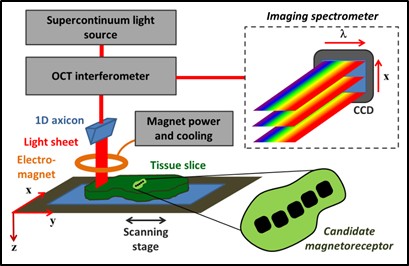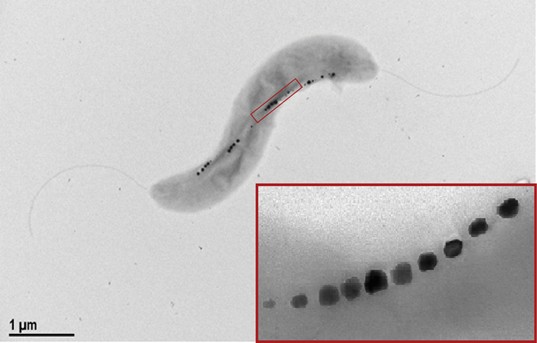

Detecting magnetoreceptors in marine animals: One application of magnetomotive imaging is the detection of magnetoreceptors in marine animals. Many different species of animals are able to migrate hundreds of miles and then return to their original nesting ground. These include all types of animals such as mammals (whales, elephants), birds (geese, ducks), aquatic animals (sharks, salmon), and reptiles (sea turtles, frogs). These animals use different navigation methods, and some of these methods remain a mystery to scientists. One example is magnetic homing in which certain animals, such as sea turtles, are able to navigate using the Earthís magnetic field. Researchers (such as our collaborator Ken Lohmann in the biology department at UNC) have shown that when placed in a tank with a variable magnetic field, the sea turtles will orient themselves according to the direction of the applied field.
However, no one is sure exactly how the turtles are able to sense the Earthís magnetic field. It is hard for us to imagine because we as humans canít feel magnetic fields. One theory is that sea turtles have tiny (~50 nm) iron-oxide crystals embedded in their tissue. These paramagnetic crystals would rotate in the presence of a changing magnetic field in order to align themselves with the field. The turtles then may somehow sense this movement of the iron-oxide crystals and use that information to know where they are relative to their nesting grounds.
One method we propose for locating these magnetoreceptors is to use Magnetomotive OCT. Because we donít know the size of the magnetite (a form of iron oxide) particles in the tissue, we would want to search for them with an ultrahigh-resolution technique, and one that is very sensitive to small amounts of magnetic particles. As shown in Fig. 1, we can envision scanning a light sheet across layers of tissue while applying a changing magnetic field from an electromagnet in order to detect any iron oxide crystals embedded in the tissue. Importantly, we have recently completed construction of such a light sheet OCT system, called Parallel Line-Field OCT for this purpose. The only remaining task is to add electromagnets into the system to perform magnetomotive imaging as in other aspects of our lab's work.

Fig. 1. Schematic diagram showing how MMOCT could be used to detect magnetoreceptors in sea turtle tissue.
The magnetoreceptor hypothesis is based upon the fact that other, smaller, organisms are known to contain such iron-oxide crystals and to use them to align with the Earthís magnetic field. Due to the size of the crystals and their magnetization, we know iron-oxide crystals to be good contrast agents for MMOCT, so we propose to use MMOCT to locate the magnetoreceptors within sea turtles. Recently, we have imaged magnetotactic bacteria that are known to contain chains of iron-oxide crystals which they use to align with Earthís magnetic field and to swim to deeper parts of the ocean (Fig. 2).

Fig. 2. Transmission electron microscopy (TEM) images of a magnetotactic bacterium. Visible within the bacterium are chains of magnetite crystals (Inset).
intro page - research - publications - people - open positions
UNC Physics & Astronomy - Biomedical Research Imaging Center - UNC Home